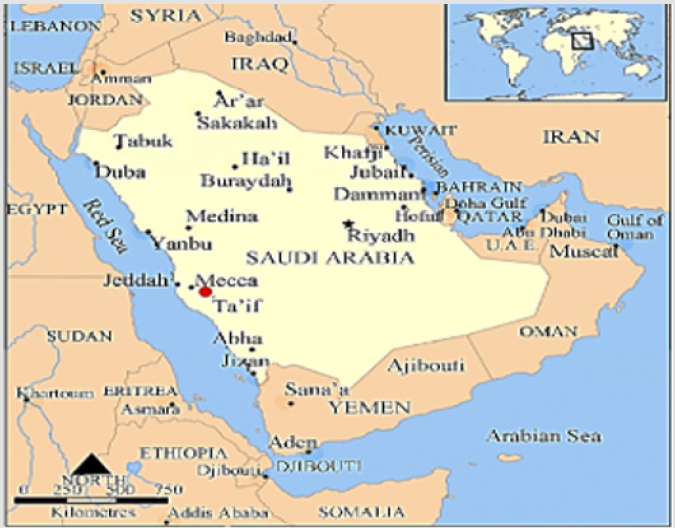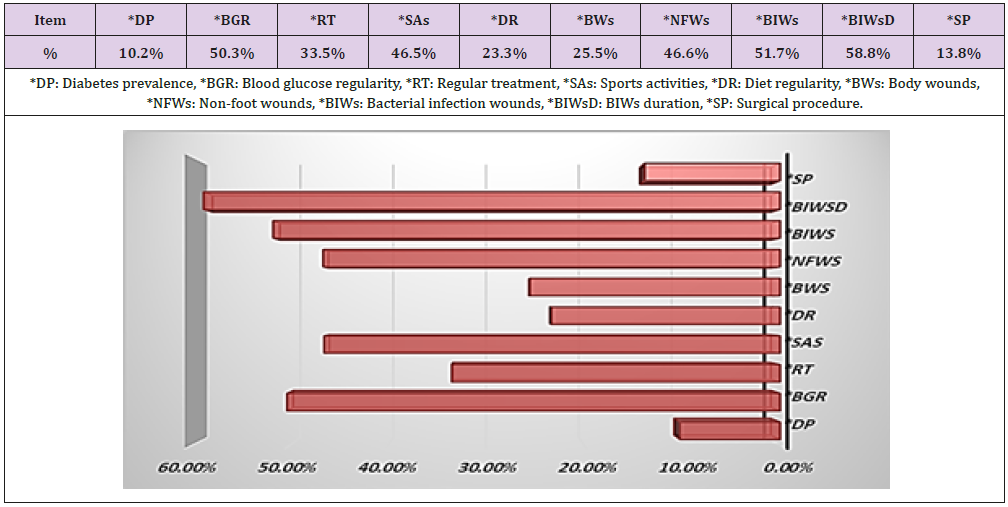Abstract
This study had conducted on diabetic individuals at high-altitude (HA) “Taif” area by the questionnaires. The diabetes prevalence (DP) was 10.2%; blood glucose regularity (BGR) was 50.3%. Regular treatment (RT) was 33.5%. Sports activities (SAs) were 46.5% less than a half; diet regularity (DR) was 23.3% about a quarter. Body wounds (BWs) were 25.5% as one-fourth, the non-foot wounds (NFWs) were 46.6%. Bacterial infection wounds (BIWs) occurred in 51.7% about a half of NFWs. BIWs duration (BIWsD) lasted a week in 58.8%, and more than one week in 41.2%, that revealed a half had long-term BIWs, surgical procedure (SP) were done for 13.8%. The HA results concluded diabetes had a significant impact on individual’s health (IH) and daily work performance. In addition, affected individual’s family life, affected the community health (CH) and community progress required. The reasons were due to lack of medication regularly, deficiency of sports activities, and failure to follow appropriate diet. Add to this presence of BIWs, which prolong the duration of treatment or lead to a surgical treatment. That recommend to developed community members to make a periodic diagnosis (PD) every six months to check-up the health state. Diabetic patients must follow-up the application of PD, medication regularity, practicing sports activities, following appropriate diet, medical follow-up and medical treatment for any BIWs. As well, all recommendations for the protection of IH with diabetes, which will help to keep people working and good performance without any defect, also will help to maintain the CH at HA areas.
Keywords: HA; DP; RT, SAs; DR; BWs; NFWs; BIWs; BIWsD; SP; IH; CH; PD
Abbreviations: DP: Diabetes Prevalence; BGR: Blood Glucose Regularity; RT: Regular Treatment; SAs: Sports Activities; DR: Diet Regularity; BWs: Body Wounds; NFWs: Non-foot Wounds; BIWs: Bacterial Infection Wounds; BIWsD: BIWs Duration; SP: Surgical Procedure
Introduction
Diabetic is a clinical syndrome associated with deficiency of insulin secretion or action. It is considered one of the largest emerging threats to health in the 21st century. The estimation say will be 380 million persons with DM in 2025 [1]. Besides the classical complications of the disease, DM had been associated with reduced response of T cells, neutrophil function, BWs, and disorders of humoral immunity [2]. Consequently, DM increases the susceptibility to BIWS, both the most common ones as well as those that usually affect only people with DM [1]. Such BIWs, in addition to the repercussions associated with its infectivity, may trigger DM complications such as hypoglycemia and ketoacidosis. WHO projects 2030, DM will seventh leading cause of death in world. BWs that occur because of various factors, as mechanical changes in conformation of the bony architecture, peripheral neuropathy, and atherosclerotic peripheral arterial disease, all of which occur with higher frequency and intensity in the diabetic population [1]. WHO has reported that KSA ranks the second highest in the Middle East, and is 7th in the world rate of DM. It had estimated reveal 7 million of world had DM. that caused BIWs by increase blood sugar levels, poor circulation, and peripheral neuropathy / nerve damage and immune system issues. DM wound were external origin and internal origin diabetic wounds. Due to peripheral neuropathy, BIWs of external origin, as skin cuts, burns, bumps and bruises, may often go unnoticed by the DM patient [3].
The aim of this study was HA area that help to cause disease due to environmental conditions as hypo-oxygen and low pressure, which reduces immunity and helps bacterial infections. Through studies found that the most important side-effects of diabetic individuals are the diabetic-foot and where it had been many studies released. The idea of side effects of diabetes mellitus included the effect of some factors mentioned in the questionnaires that help the happened of side-effects. That were included NFWs in a place other than foot, which transferred to BIWs. That will be clear when look at the results of questionnaires to match the Saudi Community at HA area and its impact on the IH and CH at HA area.
Methodology
a) Study Area: Taif region, as a HA area is located in the Western region of KSA. It is a high altitude area that it is more than 2400 meters above the sea level [4,5] Figure 1.
b) Method Used: “Survey Methodology” it was used [6].
Questionnaires preparation: It had based on the study objectives
[7]. Research Design: Subjects consisted of 10 questions
questionnaires by individuals with diabetes had included:
Diabetes prevalence (DP), Blood glucose regularity (BGR),
Regular treatment (RT), Sports activities (SAs), Diet regularity
(DR), Body wounds (BWs), Non-foot wounds (NFWs), Bacterial
infection wounds (BIWs), BIWs duration (BIWsD) and Surgical
procedure (SP) [8]. Online way: The questionnaires had added
as “Online Surveys” [9].
c) Results collection and Data analysis: Results and data
had collected and analyzed using “Simple Excel Program” to
give in tables and diagrams [10].
Results and Discussion
Table 1 and Graph 1 had revealed the mean positive results of questionnaires, according to the questionnaires that mentioned in research design of methodology. The result had shown that, the DP was 10.2%, about tenth; BGR was 50.3%, as a half. RT was 33.5% as one-third. SAs were 46.5% less than a half; DR was 23.3% about a quarter. BWs were 25.5% as one-fourth and NFWs were 46.6%. BIWs occurred in 51.7% about a half of NFWs. The duration of BIWs lasted a week in 58.8%, and more than one week in 41.2%, that revealed a half had long-term BIWs, SP were done for 13.8% only [1-3].
Conclusion
The HA-results concluded diabetes had a significant impact on IH and daily work performance. In addition, affected individual’s family life, affected the CH and community progress required. The reasons were due to lack of medication regularly, deficiency of sports activities, and failure to follow appropriate diet. Add to this the presence of BIWs, which prolong the duration of treatment or lead to a surgical treatment. The results of the present investigation had shown that there is a relationship between Diabetic and Bacterial Infection at High-altitude Area. It had recognized that altitudes >1500 m above Mean Sea Level (MSL) affect IH adversely. The International Society for Mountain Medicine had defined high altitude as 1500–3500 m, very high altitude as 3500–5500 m, and extreme altitude as 5500 m above MSL.
Acknowledgements
All thanks were sent to all body had helped in this paper. Special thankful had sent to Student “Osama Adel Kelaiker” for his offer in “Questionnaire Survey”.
Recommendation
That recommend for developed community members to make a PD every six months to check-up the health state. Diabetes patients must follow-up the application of PD, medication regularity, practicing sports activities, following appropriate diet, medical follow-up and medical treatment for any BIWs. As well, all recommendations for the protection of IH with diabetes, which will help to keep people working and good performance without any defect, also will help to maintain the CH at HA areas.
Future work
This work must repeat in normal altitude area for comparison.
Conflict
There was no conflict, because HA area had no paper with the same.
References
- Juliana C, Janine C, Cresio A (2012) Infections in patients with diabetes mellitus: A review of pathogenesis. Indian J Endocrinol Metab 16(Suppl1): S27-S36.
- Kelly H, Jodie M, Tahnee B, Brenda G, Catherine R, et al. (2015) Immunological mechanisms contributing to the double burden of diabetes and intracellular bacterial infections. Immunology 144(2): 171-185.
- Al Dawish A, Robert A, Braham R, Al Hayek A, Al Saeed A, et al. (2016) Diabetes mellitus in Saudi Arabia: A review of the recent literature. Curr Diabetes Rev 12(4): 359-368.
- https://en.wikipedia.org/wiki/Regions_of_Saudi_Arabia
- https://ar.wikipedia.org/wiki/%D8%A7%D9%84%D8%B7%D8%A7%D8%A6%D9%81
- file:///C:/Users/USER/Downloads/12-587-x2003001-eng.pdf
- https://bizfluent.com/info-8282003-aims-objectives-questionnaire.html
- Anjali S, Taruna S, Nidhi K (2017) Awareness of diabetic patients towards diabetes mellitus: A survey-based study. Nat J Community Med 8(10): 606-610.
- https://mopinion.com/top-21-best-online-survey-software-and-questionnaire-tools-an-overview/
- https://answers.microsoft.com/en-us/msoffice/forum/msoffice_excel-msoffice_custom-mso_2016/web-queries-with-excel-for-mac/0bc5634c-7610-492b-916f-b514c95e0239.

 Short Communication
Short Communication

